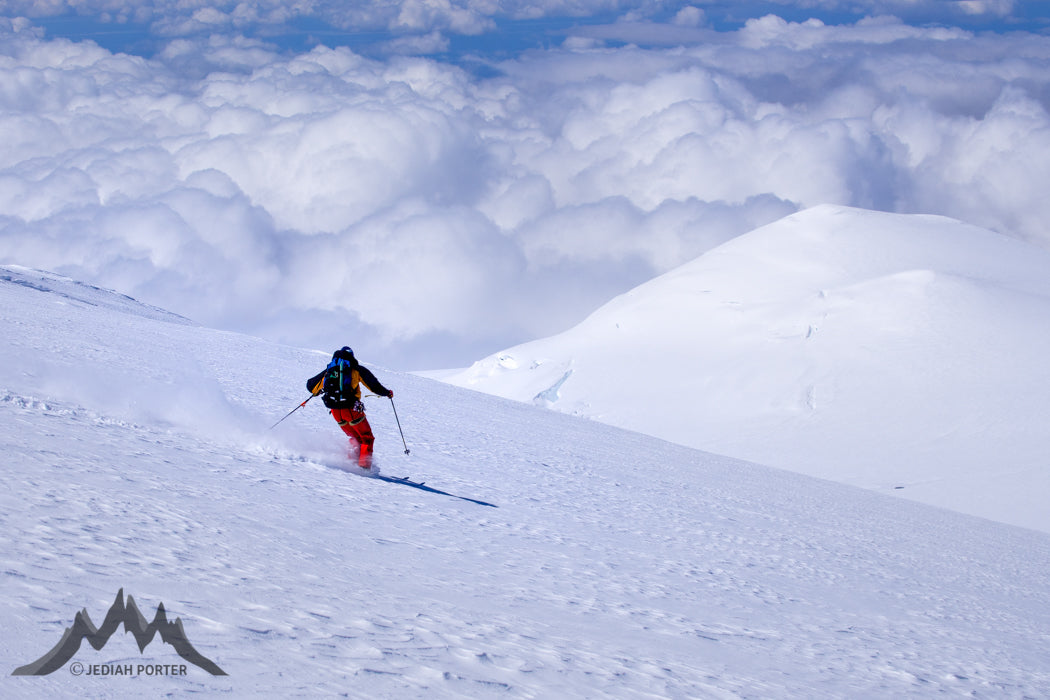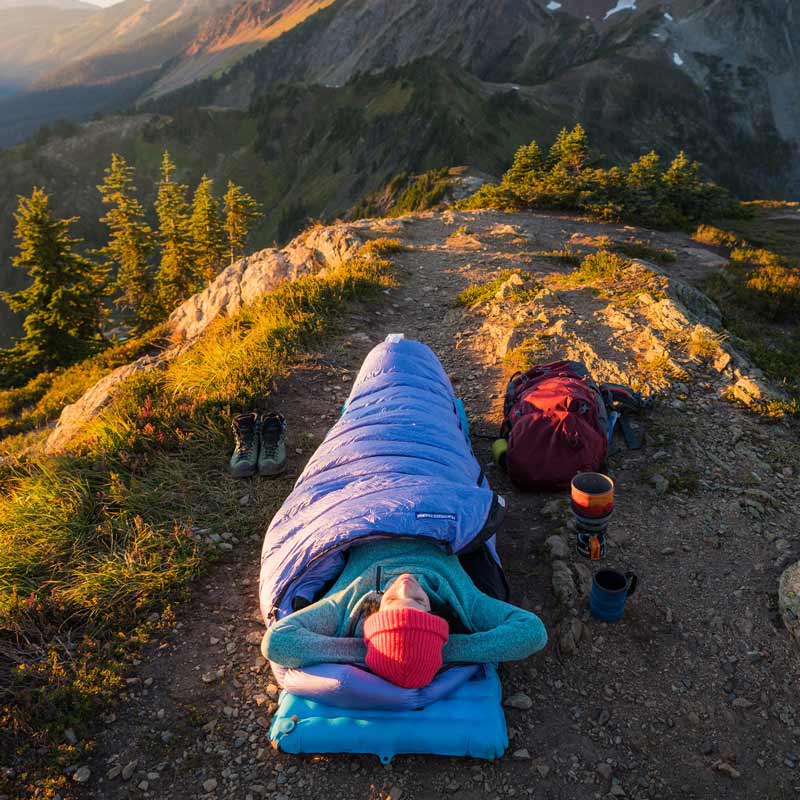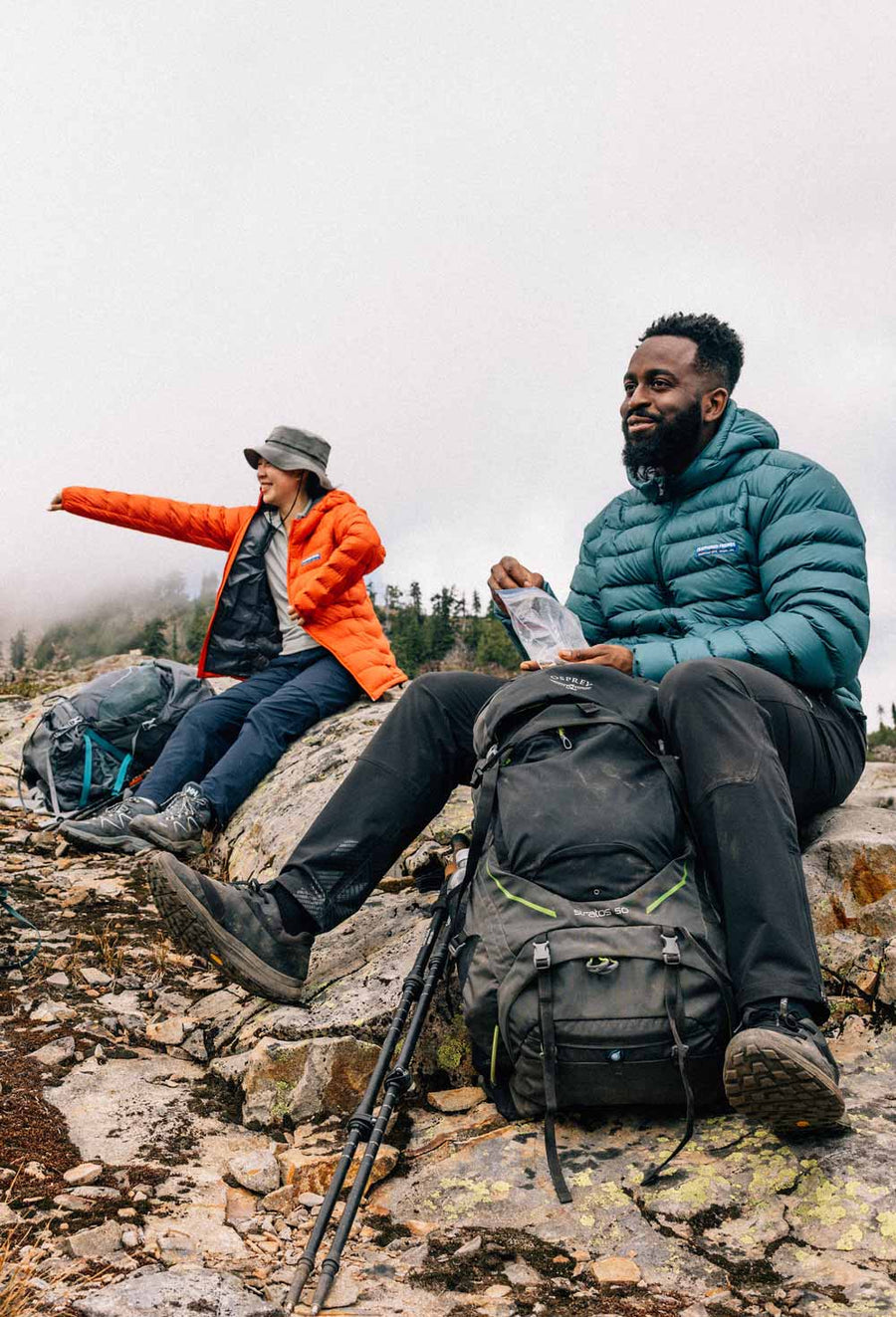Skiing Alaska’s Mount Sanford
A trip report from AMGA/IFMGA Mountain Guide Jediah Porter.

Human adventures are like caribou antlers; born soft and fuzzy with hope. Really, both start as just an idea, deep in one’s DNA. As they take shape, before they even take action, they are gentle and virtually unnoticeable. The promise of their power and prominence is there, but the scratched, hormonal, prideful reality is yet to be revealed.
For us, the climb and ski of Alaska’s Mount Sanford started as just a tiny, incubating idea in a teenager’s soul. In Wildsnow, the definitive tome on North American ski mountaineering, guru (and now mentor) Lou Dawson mentions the Sheep Glacier route on Mount Sanford as perhaps the ultimate mid-difficulty ski run on a giant peak. I stumbled across that literally 20 years ago, and the idea has simmered since then.
My wife Meagan and I booked some guiding work in Alaska in the spring of 2016, and looked to tack on a personal adventure. The time was right, the team was right, Mount Sanford was the call.

The Porcupine Caribou (Rangifer tarandus granti), native to the entire state of Alaska and adjacent portions of Canada, is an ungulate species in which both males and females have antlers. If humans have adventures while caribou have antlers, the males of each species cook up ostentatious versions, while the females prefer humbler, more practical iterations.
There is no prescribed method for climbing Mount Sanford. In the wild and relatively untrammeled Wrangell range of east central Alaska, Mount Sanford is far from the infrastructure and institutional knowledge of the state’s mountaineering hub in Denali National Park. We had various, unproven approach and exit options, and some time and creativity to work with. True to form, like my bull caribou brethren, I wanted the big and prideful version. I proposed walking in and walking out, from the roadside town of Chistochina. Meagan, undoubtedly wiser in her adventurous spirit, liked the multi-biome appeal of a walk-out, but didn’t relish the thought of thrashing across the tundra with all our climbing, skiing, and camping gear, plus fourteen days of food. Wisely, as it turns out, we opted for a compromised, far more reasonable, set up in which we flew into the high tundra, and would “walk” out under our own power.

Those first days on the tundra, approaching the mountain and watching the sub arctic wake up from a long winter, were pure magic. In many ways, this was the highlight for me. I get to the alpine wilderness quite often. What I don’t do nearly enough is walk around on dry ground just grooving out on nature. We saw foxes and caribou, ptarmigan and waterfowl. We grunted huge packs, endured gnarly sleet storms, and camped in the middle of amazing vistas.
After a few days of approaching, we gained the toe of the Sheep Glacier. In a case of serendipitous perfect timing, we went from dry-ground tundra walking to snow covered glacier, with basically nothing in between. We didn’t need to post hole in fading low altitude snow, nor did we need to carry our skis past much bare ablated glacier. From the very toe of the glacier, we skinned for days.
Big mountain, glaciated ski mountaineering is a complicated beast. There’s the work load, the weather, the crevasses, avalanche and ice fall, and altitude. Usually there is also technical terrain. Mount Sanford has all but the technical bits. Our weather was far from ideal (snow and/or rain on 9 of 11 days), the crevasses were super scary in spots (thin “continental” snow cover through the lowest ice fall), and the altitude is high (16,000+ feet at the summit. In the end we spent just two nights above 11,000 feet). The avalanche danger was minimal, primarily due to the mellow terrain. We literally never climbed nor skied terrain steeper than 35 degrees. We kept our skins on the entire way. We carried one shovel for camp management and a probe for crevasse ID, but left transceivers at home.

We were also deep in the wild. We saw no one else. By most accounts, Mount Sanford is climbed just once a year, on average. We were the 2016 representatives. With all the challenges one could face in big mountain skiing (and I mean BIG mountain… we skied 11,000 feet. Your typical ski movie “big mountain” ski line is about 1500 feet…), eliminating some is a sure way to give a margin of safety and to enhance the “vacation” feel of an endeavor. To not stress about slip and fall hazard or avalanche risk was quite welcome.

Like caribou antlers, an adventure grows and takes shape as the weeks go by. We start out with one vision, inherently a little mystified by what the point of this all is. Surely, a male caribou doesn’t fully appreciate the magnitude of changes coming to him and his life with the autumn rut. The female gets tangled in the brush with her own antlers, perhaps learning the value of her head gear only incidentally, scratching in the snow and moss to remove the itchy velvet. What is the point of all this? When will these things make sense?
For Meagan and I, our crescendo wasn’t the summit. Don’t get me wrong. Standing there on the fourth highest peak in Alaska, together, in perfect weather with two vertical miles of perfect powder below, was straight up magic. However, that’s akin to the caribou posing for a tourist photo along the Alaskan Highway. This isn’t what we’re here for. The crux, the lessons, the stories are still ahead.

We glide out a magical day, skiing literally hours down to the tundra and thicker air. We start in Volant jackets and finish the day bathing, naked, in the glacial melt; straight up mountain magic.
We put the skis away, burn our trash and some extra equipment, and put the noses to the ground for the 25 mile exit. We have hiking shoes, extra food, bear spray, and a pack raft. We can handle anything, we think. We motor seven miles that first day, side-hilling on amazing tundra under giant packs. The next day, day two of our dry-land exit, drops us below the tundra. Here, as they say, “shit got real”.

Below the tundra in Alaska is some of the gnarliest bushwhacking on earth. Even the sloping terrain is swampy. The flat terrain is fully water logged. The undergrowth is thick, tangled, and seemingly angry at ski-clad backpacks. How the antlered caribou and moose navigate the density is one of the wilderness’ greatest mysteries. We thrashed, for two-thirds of that second day off the glacier, to gain just two miles. To say we were disheartened is a gross understatement. This trip, at that moment, like the bull’s giant, velvet-shedding rack just before the rut, seemed absolutely pointless and ridiculously cumbersome. What the heck were we doing there?

In heading toward civilization, we navigated mainly parallel to Boulder Creek toward the Copper River. At times we walked right along the creek on sporadic game trails. Other times we climbed the bank to more sparsely forested “muskeg” terrain. Much of the time we thrashed blindly through alders, hoping we were heading in the right direction, but mainly just glad to make the next step. Those two miles of thrashing were absolutely brutal.
At our emotional low point, realizing that, at this rate, we’d need days and days more to reach civilization (we had hoped to go glacier to town in two, maybe three, days. We were basically two days in now, with just a third of the distance covered), we went rogue and motored perpendicular to the creek, straight south, just to try something different. At our absolute emotional lowest, we literally stumbled onto a trail. There, in the middle of the wild, was an atv track heading in the right direction! In another hour or two that afternoon, we doubled our day’s progress, eventually crashing out in the swamp four miles from where we started. The progress wasn’t monumental, but it was rewarding. This track had to come from somewhere civilized, and we were going there! Sleep came easy, relief was palpable.
The third exit day dawned optimistic. All we had, we presumed, was trail walking under the big packs. We joked about the trail petering out, of losing this “lifeline”, but those were just jokes. Right? We motored a few miles closer to town, enjoying the views more now and fantasizing about our first civilized meal. We saw more and more sign of humans; survey flagging, atv parts (that had to suck…), and eventually an abandoned hunting camp. Just past the hunting camp the trail emerged into the braids of Boulder Creek. We lost the trail briefly, but wandered in slowly expanding circles to pick it up. Those circles got a little more frantic and more of yesterday’s familiar dread seeped back in. Did we really lose the trail? What next? It’s hard enough to thrash the brush. It’s even harder when the team is on “different pages”. It’s even harderer when you’ve had relief, and then that relief is taken back. We thought we had had our low point. Here was a new one. We sat a bit, through a little rain squall, and resigned ourselves to an indefinite amount of thrashing. We navigated around and through beaver ponds, briefly found an old trail (like, very briefly… but those 100 yards were nice), and wrestled our ski “antlers” through countless alder jams.

Camp that night was cramped, annoyed, and buggy. We were absolutely done with the overland bushwhacking. It wasn’t ideal, but we had a new plan. Farther now from the mountains, the rocky channel of glacier-fed Boulder Creek had mellowed into some gravel and braids. We had a small “pack raft” for our final crossing of the Copper River. Boulder Creek, at this point, certainly wasn’t big enough to float us on the raft, but we speculated that we could put our packs in the raft and walk alongside. It took some set up, but it certainly couldn’t hurt to try. Meagan took a small pack with our most valuable possessions, while I wrangled the raft. After some unfortunate initial dead-ends and “free lessons” in raft “lining”, we slowly picked up the pace. Meagan walked the gravel bars, occasionally wading to the other side for better travel, while I walked mainly in the creek tending the boat and our gear. It wasn’t ideal travel, but it was far better than carrying the gear through the brush alongside the stream-bed.

While we still stumbled, and our feet were soaked in glacial melt for hours, the “novelty” of the creek-walking, raft-lining method of travel never wore off. All we needed to reinvigorate ourselves was to glance past the ribbon of running water into the gnarly and ever-thickening brush. Like the annual shedding of antlers, we were free to look around unburdened again. It didn’t quite make sense why we had tackled such a big dumb mission, but we did have the palpable relief of knowing the thrash wasn’t our forever fate.
Our final exit onto the Copper river gravel bars was somewhat anticlimactic. It was raining, we had battled so hard. Open terrain and the wide deep river were welcome and comforting. The Copper crossing, in planning, had been a dreaded encumbrance. In reality, all we had faced up to that point made the quick raft shuttle a virtual walk in the park. The road was just on the other side. We were met by friendly locals who shuttled us to the tiny town of Chistochina, where we found showers, changed into dry clothes, and slowly “reentered” society.
Our metaphorical antlers still sit there on the slopes of the Wrangell mountains. In some ways, publishing this is like showing off our shed calcium. Maybe you’ll appreciate the former glory. Maybe you’ll chew a little off for your own use. Most likely, this will sink into the moss and be forgotten. Meagan and I will tackle other equally ridiculous adventures, with disturbing regularity. Caribou will keep growing and shedding antlers, somewhat oblivious to the point of it all. We’ll forget the pain and annoyance of “biting off more than we can chew” while the caribou knock and bang through the alders again next season.
The post Skiing Alaska’s Mount Sanford appeared first on Expedition Tales.









Leave a comment